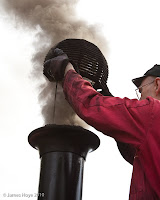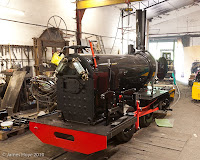As with any day, there is lots going on and I have tried to capture a flavour of what's happening.
Due to its length, this posting has been split into two parts.
Locomotive preparation
Although Bressingham opens its doors to the public at 10:30, the drivers must arrive around 7:30 in order to prepare the locomotives for the day. The whole process can take up to three hours.07:30 Steam valve repair
Before any preparation could begin on Bronllwyd, Brian (today's Duty Engineer) had to replace a faulty steam valve that had been reported on Saturday. With the part quickly replaced from the workshop's extensive spares inventory, Graham (today's driver) was cleared to start firing the engine.07:45 Cleaning the boiler tubes
Running through the middle of the boiler are several dozen tubes. These are surrounded by water and the hot gases from the burning coal pass through these tubes to the chimney at the front where they are vented. After a day's running soot and other deposits build up inside these tubes and this reduces the boiler's efficiency. The morning's first job is to clean every tube along its entire length with a special brush on a long pole. All of the soot is then swept out with a brush and disposed of, and a visual inspection of the tubes and smokebox performed to ensure that there are no obvious signs of damage.Once the smokebox door has been brushed and is relatively free from soot, a thick coat of steam oil is painted onto the outside edge of the smokebox. Steam oil is extremely viscous and this provides a seal when the door is closed and tightened. This prevents air leaks and ensures that the chimney provides a good draught to draw the hot gases through the boiler effectively.
08:00 Raking the ash
The next task is to rake all of the ash and clinker out of the firebox and then to empty the ash pan. With the firebox clear a visual inspection is performed to ensure that there are no visible signs of damage such as cracking or buckling. Even though the locomotives are shutdown around 17:00 the previous day, you can still feel quite a bit of warmth and feel the draught as you put your face to the firebox when checking some fourteen hours later.08:15 Lighting the fire, topping up the regulator and polishing
With everything in order, pieces of kindling are laid and a rag soaked in paraffin is lit and placed with the kindling. The trick is to let the wood burn thoroughly before adding any coal, and then only a little coal at a time. The colour of the smoke from the chimney gives a good indication of how the fire is progressing to the trained eye. Graham tells me that it is important not to rush this part.With no steam pressure in the boiler, the regulator can be topped up with steam oil. Since this oil is so thick it is hard to pour so Graham leaves the can on top of the boiler for a few minutes to warm it and make it easier to pour.
Whilst the fire is building and the engine fairly cool, attention turns to polishing the pipework. This needs doing every day as the copper pipework and brass fittings tarnish very quickly as oxides form on the hot surfaces. An aluminium paste is applied to all of the visible pipework and fittings whilst checking on the progress of the fire from time to time. With the fire taking, the pipework is getting hotter all of the time and removing the polish (with an old sock) becomes trickier and soon requires gloves as well.
Once gleaming the build up of heat means that the oxidisation process starts as soon as the polishing has finished, but you get the most wonderful colours forming on the pipework as cuprous oxide (Cu2O) is formed. The hues change throughout the day as the copper pipework changes temperature. The aluminium in the polish must also contribute to the colours as rubies and sapphires are forms of alumininum oxide.
08:30 Lubrication and cleaning
Now that the fire is coming along well and most of the metal polishing done, it's time to concentrate on lubricating the various components. The regulator assembly has already been done but that was just the start. Each cylinder has a reservoir (See the Bevan image further down this page) that keeps it lubricated and these both need topping up with steam oil. Graham will check these later in the day, and top up again if necessary.A final glug of thick steam oil into the reservoir for the steam brake leaves just the motion to do a little later. Now that the fire is well and truly going it's time to fit the spark arrestor. This cage-like device is placed on top of the chimney and is intended to prevent any errant sparks from setting the line-side vegetation alight. When it's not quite so dry as today it is sometimes omitted.
Spray polish is used to clean all of the paintwork, and the remaining copper pipework is polished off. With more coal being added to the fire, steam pressure is now starting to build.
09:25 Pressure building
An hour away from duty, the steam pressure has risen to just over 40psi. Bronllwyd's working pressure is 140-150psi, but the fact that we have pressure means that the water in the boiler has all been heated and steam should now build steadily.In the lower right of the image the steam valve that Brian replaced earlier can be clearly seen. You can click the any image for a larger version. Use your browser's back button to return here.
09:30 More lubrication and more cleaning
One of the final tasks is to lubricate the moving parts, collectively termed the motion. A machine oil is applied to various points on the linkages and the axle boxes are topped up. Depending on the positioning of the wheels sometimes this cannot be completed until the locomotive has been moved forward a short distance to allow access through the spokes. Again, with this task it is an ideal opportunity to check various parts for damage or signs of wear.A paraffin soaked rag brings some colour back to the wheels and a final check round the locomotive gives it the all clear. It's amazing just how dirty a steam locomotive gets during the course of a day!
10:20 Preparation complete
Bronllwyd ready for the day's work
I thank Graham for allowing me to observe and ask lots of questions, and head across to the standard gauge to see if Ivor is ready.
If you would like to try your hand at driving a steam locomotive then there is a Driver Experience package available where you get to help prepare the locomotive before enjoying a minimum of two hours' driving.
Terms and conditions apply.
Terms and conditions apply.
Ivor has steam
On the way I pass one of the traction engine drivers who is busy with his engine preparation as well. Whilst the steam is building, there is always plenty of copper, brass and paintwork that needs polishing.Having previously experienced a ride on the road roller I will at some point try to shoot some video to give an idea of what to expect. One thing that won't be possible is to convey though is the sensation of riding on twelve tons of machine without any suspension.
Over the standard gauge crossing Ivor is just about ready to head down the line to be coupled up to the passenger carriage which is stationed by the Waveney platform.
Lots of progress on Bevan
With Ivor ready for duty and Bressingham's doors open to the public I grab my tripod and head for the workshop to check up on Bevan and get some better photographs (the last set were hand-held at ISO3200).Since my last visit much progress has been made on Bevan. The painted boiler that was covered up on a wagon in the engine shed has now been fitted to the chassis and looks great with its gleaming black paintwork. This time I have time and a tripod on my side so the pictures are much better and have a greater depth of field. For information I was shooting with a shutter speed of 10 seconds (and f/11 at ISO100).
Wilst in the workshop, Brian the Duty Engineer wanted to show me the cab that he was painting over in the Horsepital. He explained that the primed areas (in grey) would be painted red and a blue coach line applied where the burgundy and red meet. He also showed me the two saddle tanks which were behind and explained that these were made from scratch.
Apparently Bevan was donated to Bressingham as a pair of axles, a boiler, smokebox and chimney, a chassis complete with cylinders but in need of repair and assorted parts like gauges and coupling rods, hence the term scratch build. Assemblies like the saddle tanks and driver's cab have been fabricated, and parts like the brakes, wheels, pipework and valves are all new.
At this rate Bevan will soon be running, perhaps as early as July or August. As with everything, it depends on being fitted in around operational maintenance and repairs. Let's hope that not too many things break.

























No comments:
Post a Comment
Please note that comments are moderated and may not appear immediately.